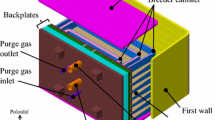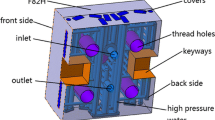Abstract
Helium is attractive for use as a fusion blanket coolant for a number of reasons. It is neutronically and chemically inert, nonmagnetic, and will not change phase during any off-normal or accident condition. A significant disadvantage of helium, however, is its low density and volumetric heat capacity. This disadvantage manifests itself most clearly during undercooling accidents such as a loss of coolant accident (LOCA) or a loss of flow accident (LOFA). This paper proposes a new helium-cooled, tritium breeding blanket concept which uses a metallic structure, and which performs significantly better during such accidents than related designs. The proposed blanket uses modified, reduced-activation HT-9 steel as a structural material and is designed for neutron wall loads exceeding 4 MW/m2. This concept uses novel features such as: (1) a “beryllium-joint” design which allows beryllium to be used to conduct heat away from the first wall, while accommodating swelling of the beryllium, and (2) a shield cooled by naturally circulating water. These features help the blanket passively withstand a worst-case undercooling accident scenario.
Similar content being viewed by others
References
C. P. C. Wonget al. (1990). Blanket Design for the ARIES-I Tokamak Reactor.Proc. IEEE 13th Symp. on Fusion Eng., Knoxville, TN, p. 1035.
F. Najmabadiet al. (1991). The ARIES-I Tokamak Reactor Study, Final Report, UCLA-PPG-1323.
D. L. Smithet al. (1984). Blanket Comparison and Selection Study, Final Report, ANL/FPP-84-1.
W. D. Turner and M. Simon-Tov (1971). HEATING3-An IBM 360 Heat Conduction Program, Oak Ridge National Laboratory Report ORNL-TM-3208.
J. E. Massidda and M. S. Kazimi (1987). Thermal Design Considerations for Passive Safety of Fusion Reactors, PFC/RR-87-18.
S. Fetter (1987). The radiological hazards of magnetic fusion reactors.Fusion Technology. 11, 400.
M. A. Abdouet al. (1987). Modeling, Analysis and Experiments for Fusion Nuclear Technology (FNT Progress Report: Modeling and FINESSE), University of California at Los Angeles Report UCLA-ENG-86-44.
R. Alcouffe, F. Brinkley, Jr., D. Marr, and R. O'Dell (1984). User's Guide for TWODANT: A Code Package for Two-Dimensional Diffusion-Accelerated, Neutral-Particle Transport, Los Alamos National Laboratory Report LA-10049-M, Revision 1.
G. R. Longhurst (1991). Beryllium Technology Workshop: Summary by Workshop Chairman, in Idaho National Engineering Laboratory report EGG-FSP-10017.
D. Smithet al. (1991). ITER Blanket, Shield, and Material Data Base, ITER Documentation Series, No. 29, International Atomic Energy Agency, Vienna.
F. M. Mann (1990). REAC3 Users Manual, Westinghouse Hanford Company.
Author information
Authors and Affiliations
Additional information
Supported by a USDOE Magnetic Fusion Energy Technology Fellowship.
Rights and permissions
About this article
Cite this article
Crosswait, K.M., Meyer, J.E. Passive safety in a helium-cooled tritium breeding blanket with steel structure. J Fusion Energ 12, 41–45 (1993). https://doi.org/10.1007/BF01059353
Issue Date:
DOI: https://doi.org/10.1007/BF01059353




